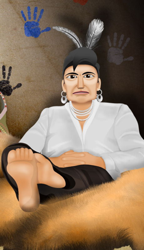I was super-excited to have had the chance to speak at Minot State University on how we use Native American culture to teach math.
In analyzing our data, one key issue we found was PERSEVERANCE. That is, students simply give up when it gets the least bit hard. It wasn’t just us that see sticking with it in the face of difficulty. It’s actually the very first standard for mathematics practice in the common core standards
Make sense of problems and persevere in solving them
The first four levels of Spirit Lake: The Game use math that is pretty easy. This is actually based on good game design. Most popular games that people play a lot start off easy and you can zip through the first few levels. Then, it gets more challenging.
Just before level 5, as the math starts to ramp up, players see these instructions …
In traditional Native American societies, everyone worked hard. Can you imagine when a Dakota hunting party went out that one of the hunters would sit down under a tree and whine,
“You other hunters go on without me. I’m tired. It’s hot. Have you seen those tatanka ? Those things are really big! I think I’ll nap in the tipi here while the rest of you go hunting buffalo. It just sounds too hard. Just give me some of the meat when you get back.”
 Can you imagine any real warrior ever saying anything like that?
Can you imagine any real warrior ever saying anything like that?
To earn your arrows, you need to do some work. Read these next pages on how to solve problems.
When you are done, you will be back to the game – with your arrows!
This type of lesson doesn’t just occur once in our our games, but over and over. As we have analyzed the data and found perseverance to be a major problem, in our updates, and our new games, we’re adding more to emphasize the persistence part in math achievement.
Another factor that we have observed on the reservation schools that differs from our experience piloting the games in California, is that use of tribal elders from local communities has a very noticeable impact on student attention. Even if the narrator is from another reservation, the students – literally – sit up and listen closely, trying to figure out if it is someone that they know.
So, of course, just after that screen that talks about perseverance, the lesson on problem-solving is narrated by Dr. Erich Longie.
It’s just a couple of little things – but that’s what makes an educational game that works – thousands of little things added up.
Thousands of small things = 1 big thing
It’s just math!
